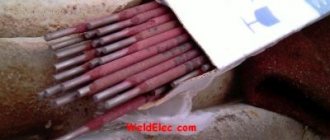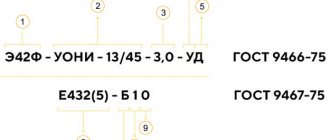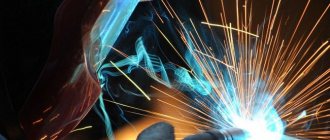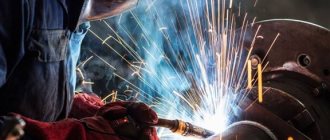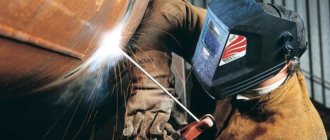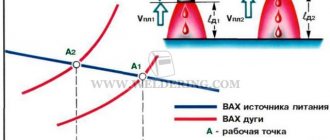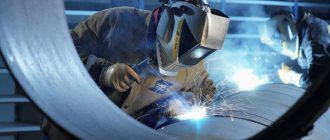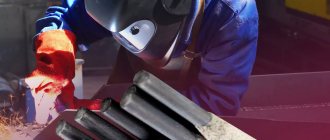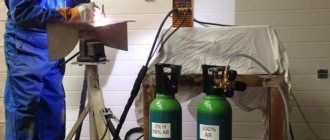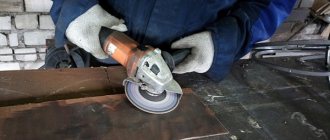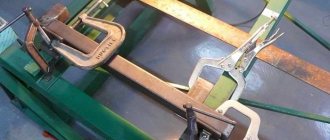Welding electrodes should be divided according to their purpose, the composition of the coating (its type), and methods of use (the type of welding current used). The principles of welding with coated rods are based on melting them using an electric current. In this case, the coating material simultaneously turns into a mixture of gases and protective slag, which protect the welding zone. The composition of the metal of the rod depends on the composition of the parts being welded: it can be steel, cast iron, a mixture of copper or aluminum with other (auxiliary) elements.
Types and purpose of welding electrodes
With welding you can:
- connect metal parts;
- manufacture metal structures of any size;
- cut metal;
- eliminate cracks;
- cut round and shaped holes;
- weld metal to restore wear areas;
- carry out repairs and other types of work.
The industry produces many types of electrodes, about two hundred of them. Each of them is most effective within the limited characteristics of these works, so the choice of electrodes for welding is a very important step. It should be done after thoroughly studying the topic or with the help of specialists.
The criteria for selecting electrodes are the design parameters, characteristics and purpose specified by the product manufacturer. The main ones are:
- electrode brand;
- appointment;
- core diameter;
- type of electrode coating;
- electrode length;
- the magnitude of the working current;
- type of current and polarity of connection;
- composition of the central rod;
- welding position;
- special technological characteristics of the welding process.
Test methods
Linear dimensions are examined with an error of 1 mm. The depth of the dents and the length of the exposed part of the rod are measured with an error of 10 times less, that is, with 0.1 mm. To determine the thickness, measurements are carried out on three sections of the product, between which a distance of 5-10 cm is maintained. To measure this value, a micrometer is used, as well as high-precision magnetic devices.
Welding and technological indicators are checked by creating branded products . On double-sided products, the likelihood of cracks in the seam is checked. The quality of the weld is checked for cracks using a 5x magnifying glass.
Purpose
The brand of the electrode, as a rule, encrypts its purpose. For example, product types:
- UONI - designed for welding parts at low temperatures;
- ANO-21 - for performing work with thin (up to 4 mm) parts operated under low pressure;
- MP-3S - for welding rolled parts and medium-carbon steels up to 20 mm thick;
- LEZ - for surfacing worn parts;
- inexpensive universal-use OZS-12 electrodes are recommended for welding carbon steels and are easy to use;
- rutile products of the ANO-4 grade are used for welding low-alloy and low-carbon steels; work on both direct and alternating currents; They cook metal contaminated with rust well, have a stable arc, and are easily cleaned of slag.
Experts distinguish between electrodes for welding, tacking, surfacing and cutting. Universal products are in great demand, saving a lot of time when performing various types of work.
Dimensions
Electrodes are manufactured according to nominal diametrical dimensions . When ordering in bulk, some manufacturers can produce products with custom sizes. Sometimes the coating on the edge is not cleared, but both ends must remain in contact. In the total batch, no more than 10% of electrodes have a length deviation of 4 mm.
The electrode is made of several structural elements: 1 – rod; 2 – transition zone; 3 – coating; 4 – contact end.
The cleaning area has a conical, round or combined shape. The inclination of the cone is not regulated in any way, since it does not affect operation.
Ionizing elements are applied to the contacts, which facilitates the appearance of the welding arc. Product marking: electrodes E46 GOST 9466-75 with a diameter of 4 mm.
Diameter
The choice of electrode (core) diameter is determined by the thickness of the parts being welded and the maximum current of the welding machine used. The higher they are, the thicker the connected elements can be.
All three parameters are dependent on each other. Their values are indicated in special tables, which are convenient to use before work and purchasing electrodes. So, for parts with a thickness of 3-4 mm, you need to use electrodes with a diameter of 3 mm with adjustable operating current within the range of 80-160 A.
What functions does the electrode perform?
A consumable electrode is a metal core made of steel welding wire (GOST 2246-70) and has a special coating. Depending on the brand of metal being welded, select the appropriate wire for the core - low-carbon, alloyed, high-alloyed.
During welding, the core melts, filling the weld pool. Thanks to the elements included in the coating, a slag layer is formed, which protects the weld pool.
Coating of electrodes
The core coating is a solid composition, a kind of flux, designed to protect the molten metal from the harmful effects of oxygen, which, when it enters the liquid metal, forms oxides that deteriorate the quality of the connection.
Another function of the coating is to thermally insulate the melt to delay the solidification time (so that harmful gas and non-metallic inclusions have time to escape from it). Modern electrodes use several types of coating. The main ones are basic (in the marking of electrodes, indicated by the letter “B”) and rutile (letter “R”).
Basic coating
It is known that it contains calcium salts - carbonate and fluoride. Its advantage is considered to be a low hydrogen content. Typical representatives of electrodes with basic coating are UONI products. Their coating ensures a high-quality seam, both in appearance and in technical indicators: ductility, strength, impact strength.
The electrodes do not form crystalline cracks inside the seam, therefore they are recommended by specialists for critical welding operations and for products operated in harsh climatic conditions. They can be used when welding in any position except vertical.
Acceptance rules
Acceptance testing in accordance with the requirements of the current standard is mandatory. The inspector analyzes the condition of the electrodes for compliance with technical specifications, checks the appearance and the absence of moisture in the packaging.
All products from a batch are manufactured according to a single technical process, on identical machines, using the same brand of wire.
From 1 ton of batch, 0.5% of electrodes are selected from various packing places. If the study shows an unsatisfactory result, then it is repeated, but with a double number of products. The result of the second analysis is final and applies to the entire batch. In the event of a defect, you must act immediately by contacting the supplier.
The presence of moisture, deviations in the size and number of pores are eliminated by calcination, followed by diagnostics for compliance with welding and technological qualities.
Rutile coating
Rutile is titanium dioxide. In addition to it, the coating contains silicon and oxygen.
Rutile coating is characterized by the following properties:
- formation of a high-quality seam at any spatial position of the electrode;
- stable arc burning;
- minimal splashing of melt and coating;
- possibility of welding on both direct and alternating currents;
- possibility of welding rusty and dirty parts;
- quick and easy ignition of the electrode;
- easy removal of slag.
Current source
To weld metals with electrodes, welding transformers, rectifiers, inverters and other devices operating in manual arc welding mode are used. The inverter is widely used due to its compactness, light weight and wide capabilities.
It provides operation on both direct and alternating current, and its light weight is explained by the fact that voltage transformation is performed at a frequency not of 50 Hz, but of 100 kHz, for which the size and weight of the transformer core is reduced by an order of magnitude.
When welding with direct current, the polarity of the connection matters. With direct polarity, the ground (welding part) is connected to the “+” of the source, and the holder with the electrode is connected to “-”. With reverse polarity, the opposite is true. With direct polarity you can weld thin parts, and with reverse polarity you can weld massive parts.
When selecting electrodes, using the table and data on the welding machine, you can determine whether the source can provide the required amount of current.
Classification of electrodes for manual arc welding
When considering different types of electrodes for manual arc welding, attention should be paid to the fact that various coatings can stabilize the resulting arc during combustion. All types of rod coating have their own characteristics, which should be taken into account when considering the types of electrodes for manual arc welding. The same brands can be produced by different manufacturers. It is worth considering that the quality of consumables may vary significantly.
The purpose of the electrodes can be very different. Based on this criterion, the following classification of manual arc welding electrodes is carried out:
- Alloyed metals have become quite widespread, since the addition of various chemicals significantly improves their performance characteristics. Some chemicals can significantly increase the heat resistance of a metal. For such alloys, electrodes are used, which are marked with the letter “T”.
- For welding steels that have a low concentration of impurities, design options are used, which are marked with the letter “U”. In addition, such electrodes for manual arc welding are suitable for metal compounds with an average carbon concentration. The achieved tensile strength value is 600 MPa.
- Structural steels have also become very widespread. They also contain alloying elements. The tensile strength in this case is 600 MPa.
- In some cases, metal may be soldered onto the surface. Metal can have exceptional performance qualities. For this case, a design option is suitable, which is designated by the letter “N”.
- There are electrodes on sale designed for steels with a high concentration of alloying elements.
- A separate group includes steels that have high ductility properties. It is quite difficult to work with such a material, so they began to produce electrodes for aluminum or other similar alloys. The marking indicates the letter “A”.
Types of electrodes for welding
The diameters of electrodes for manual arc welding can differ significantly, which is due to the characteristics of the work being performed. Classification is also carried out according to the thickness of the coating being created. The following types of electrodes are distinguished:
- With a thin coating. When designating, the letter “M” is used. As a rule, in this case the surface layer is about 20% (the indicator is taken from the total diameter).
- With medium coating thickness. When designating, the letter “C” is indicated. In this case, a layer is applied whose thickness is 45% of the diameter of the rod used during manufacture.
- The thick coating is 80% of the diameter and is marked with the letter “D”.
- There are also particularly thick versions, which are designated by the letter “G”. In this case the thickness is more than 80%.
Do not forget that electrodes may have restrictions on their use and position during work. An example is that some substances have increased fluidity, and it will be difficult to carry out work near the ceiling surface. In order to quickly determine the purpose of the electrodes for manual arc welding, a certain marking scheme is used:
- 1 – design options that can be used in almost any position. This is due to the fact that the coating used retains its shape and is not too fluid.
- 2 – can be used in almost all positions, with the exception of work with a vertical position of the tool used.
- 3 – these electrodes are designed for horizontal and vertical use, ceiling position is excluded
- 4 – electrodes for manual arc welding, which can only be used in a horizontal position.
Different brands of electrodes for welding
It is worth considering that different countries have different labeling standards. On sale there are electrodes for manual arc welding from domestic and foreign manufacturers, the classification of which may differ significantly.
Welding position
The spatial position of the electrode is also included in its marking. The number 1 denotes electrodes that are used for welding only in the lower position of the part (electrode on top).
The number 2 marks products used with a horizontal or vertical seam (ceiling is excluded).
Number 3 is used for ceiling electrodes (the electrode rests on the part from below). The welder must take these markings into account to avoid a poor-quality weld or injury.
Packaging, labeling, transportation and storage
To determine the varieties and characteristics, the labeling should be analyzed. The packaging contains information about 9 main indicators of welding electrodes according to GOST:
- Type . The designation begins with the value “E”, which indicates the electrode, followed by numbers that show the permissible tensile force, followed by the index A, which describes the resistance of the seam to impact stresses.
- Brand . The parameter is regulated by the policy of the manufacturer.
- Diameter _ The thickness of the internal zone of the electrode is in the range of 1.6 – 12 mm. For domestic use, devices with a thickness of no more than 5 millimeters are used. Electrodes with a diameter of no more than 2 mm are common in enterprises involved in the production of small-sized devices.
- Purpose . According to this parameter, products are designated by letter values - U, L, T, V, N.
- Thickness _ The parameter is characterized by the ratio of the inner part of the rod to the size of the coating.
- Seam properties . The characteristic indicates the percentage of chemical elements of the alloy and the operating temperature of the weld. Detailed decoding can be seen in special tables.
- Type of welding current and connection method.
- A type of electronic coating.
- Location markings.
There are several types of electrodes. Correct decoding of the marking allows you to choose the most appropriate product for a specific task. Products are packaged in packs or boxes:
- sealed plastic cases;
- packages in wrapping paper placed in metal containers;
- boxes with a minimum cardboard thickness of 0.7 mm, wrapped in polyethylene;
- cardboard boxes with a thickness of more than 0.8 mm;
- packs with a sealed shell and wrapping paper;
- packaging made from two-layer special paper or a moisture-resistant analogue.
Deputy General Director of NPO Spetselektrod LLC Bystrov V.I.: “Transportation and storage conditions have a huge impact on the quality of electrodes. Therefore, several complete checks are carried out before dispatch. The boxes are placed in medium-sized containers, the loading must be carried out to the fullest extent, and shelves are installed between the tiers. Each tier cannot exceed 60 cm in height.”
Each batch is supported by a quality certificate. Electrodes are stored in rooms with minimal humidity and temperatures above 15 degrees.
Calcination of electrodes
Coating of electrodes requires tightness during storage, but this condition is not met everywhere. The sharp edges of the rods, as a rule, break the tightness of the plastic packaging already during the first transfer of packs. Thus, by the time of purchase, the electrodes are saturated with excess atmospheric moisture.
In this condition, due to the danger of obtaining a poor-quality seam and the possibility of too much metal spattering, welding cannot be performed with them. The electrodes need to be dried. The manufacturer gives clear recommendations regarding process parameters, setting drying time and maximum temperature. It usually does not exceed 260 ºС.
Technical requirements
Metal consumable electrodes are manufactured in accordance with GOST 9466-75, but with modifications. The main element is made of special wire . The coating is durable, without pores, swelling, or cracks. The presence of minor irregularities is normal; deep dents and lingering scuffs are considered defective. The length of the damage does not exceed 3 times the diametrical size. The normal depth of dents is up to 50% of the total thickness of the coatings; there can be up to 4 of them with a total length of maximum 25 mm on the product.
How to determine the quality of electrodes when purchasing?
The best option would be to test several electrodes from the purchased batch in the welding workflow. If this is not possible, you need to pay attention to the following factors:
- shelf life of products;
- name of the manufacturing company (for experienced welders this is important information);
- quality of coating in terms of uniform thickness of application around the rod, absence of crumbling.
If during testing there are signs of excessive moisture, the electrodes should be dried and the test repeated.
In order for the welding of parts to be carried out in accordance with all the rules of the regulations, and the quality of the seam not to be criticized, it is extremely important to study welding technologies well. The choice of electrode type is an integral part of this knowledge, which needs to be constantly replenished and improved.
Brands of quality electrodes
Among the products of various manufacturers, there are companies that have become the most popular in the welding consumables market due to their quality, low cost and accessibility to consumers.
Among these manufacturers are:
- Russian brand UONI, whose products are also produced in neighboring countries. Works with all types of steel and cast iron. The resulting seams meet the requirements of domestic standards.
- The Japanese company Kobelco has certified the Lb-52U product line with reliable protection inside the joint, easy removal of slag, and a minimal amount of scale. The products are certified by NAKS.
- ESAB offers several types of electrodes. OK 94.25 work with cast iron, tin bronze, and non-ferrous metals. OK 96.20 for welding aluminum without the use of inert gases. OK 61.30 for processing stainless steel under thermal load.
In addition, products from factories such as KISWEL (South Korea) are widespread; Resanta; Lincoln Electric (USA), QUATTRO ELEMENTI (Italy).
